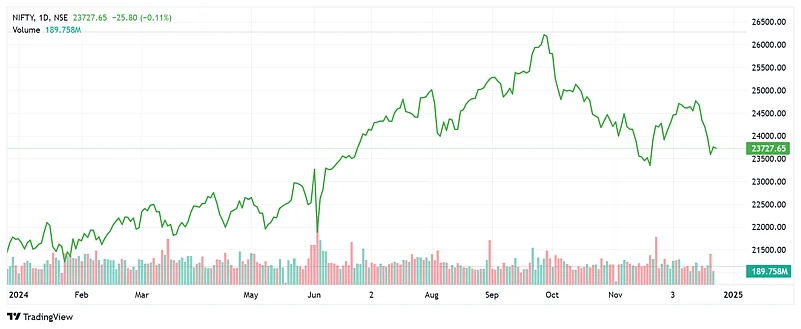Indian domestic markets are ending the calendar year 2024 on a positive note, with the benchmark Nifty 50 index posting a 13 per cent gain on a year-to-date (YTD) basis – its ninth consecutive year of positive gains.
In the first half of 2024, the Indian stock market witnessed strong corporate earnings, a rise in domestic inflows and a stable macroeconomic environment, pushing the Nifty 50 to a historic high of 26,277 in September 2024. Despite facing several challenges, including global geopolitical tensions, the General Elections and the Union Budget, the market showed remarkable resilience. Any downturns were quickly countered by robust buying interest, highlighting investor confidence.
However, in the last two months, the market has corrected 11 per cent from its all-time high. This correction market the third major decline since the COVID-19 pandemic in 2020, driven by unprecedented selling by Foreign Institutional Investors (FIIs) amid a mix of domestic and global challenges.
In October and November, FII outflows touched Rs 1.5 lakh crore, the highest-ever two-month selling spree on record. In addition, earnings moderation, high valuations in mid-caps and small-caps, and a strengthening dollar index following Dollar Trump’s victory led FIIs to reduce their exposure to India.
However, the BJP’s decisive victories in the Maharashtra and Haryana state elections in late November reignited optimism in the markets. Investors expect increased government spending favourable policy reforms and the swift execution of key infrastructure projects. The sentiment was further boosted by a 50 bps reduction in the Cash Reserve Ratio (CRR) by the RBI, which is expected to enhance liquidity in the financial system.

As 2024 concludes, experts foresee a mixed outlook for 2025, with a combination of consolidation and recovery driven by domestic and global economic factors. Here’s what top brokerage firms are projecting for the year ahead.
Motilal Oswal Wealth Management
Motilal Oswal Wealth Management projects that 2025 could unfold as a tale of two halves. The first half may see continued market consolidation, while a recovery is expected in the second half. Indian markets will likely be influenced by a mix of global and domestic economic events. Key factors include the anticipated RBI rate cut in February 2025, ongoing US rate cuts, and potential trade policy changes after Donald Trump’s return as US President. The Union Budget in February will also provide crucial signals to the market. Given a fragile global economic environment and mixed domestic macroeconomic factors, markets are expected to remain in consolidation mode in the near term.
After a subdued earnings performance in the first half of FY25, earnings are expected to recover in the second half, supported by increased rural spending, a buoyant wedding season, and a pick-up in government spending. Earnings momentum is projected to deliver a 16 per cent CAGR over FY25-27E. The recent market correction and moderation in valuations offer opportunities for selective bottom-up stock picking. Long-term prospects remain positive, backed by the strength of corporate India’s balance sheets and the outlook for robust, profitable growth.
Standard Chartered
As we enter 2025, Standard Chartered is adopting an overweight stance on equities within its foundation allocations, funded by an underweight position in cash. It expects India’s growth and corporate earnings to be supported by a pick-up in government spending and a recovery in consumption demand, especially as the RBI begins its policy easing cycle.
However, challenges remain, including the potential impact of Donald Trump’s policies on emerging market assets, the uncertain growth outlook in China, and elevated domestic inflation. To navigate these hurdles, Standard Chartered suggests that investors increase risk in foundation allocations, add hedges to limit downside, and preserve yields on long-maturity bonds.
Within equities, Standard Chartered is overweight on large-cap stocks, while maintaining a neutral view on mid- and small-cap equities. In the bond market, it favors medium- and long-maturity bonds. Gold remains a key hedge in the portfolio. The bank also sees tactical opportunities in small-cap equities, specific Indian equity sectors, long-maturity bonds, and high-quality corporate bonds, positioning for potential gains in these areas in 2025.
Mirae Asset's Sharekhan
According to Mirae Asset's Sharekhan, equity markets witnessed a solid rally in CY2024 despite a year filled with significant events, including elections in India and the US, rising geopolitical tensions, and the beginning of the interest rate reversal cycle.
However, the rally lost momentum in Q4 due to a slowdown in Q2 earnings, sustained selling pressure from FIIs driven by rising US bond yields, and a strengthening US Dollar. Despite these challenges, it was still a strong year for retail investors.
Looking ahead to 2025, Sharekhan suggests that the market may face a breather, with similarities to the macro environment of 2018. The domestic economy is experiencing a mid-cycle slowdown, and earnings growth is expected to moderate significantly, with a low single-digit growth rate projected for FY2025. Globally, there could be renewed trade tensions and currency volatility with the return of Trump’s administration. As a result, it would not be surprising if benchmark indices enter a consolidation phase, with a healthy correction in the broader market, which may eliminate the speculative froth in small- and micro-cap stocks built up over the past two years.
Bajaj Broking
According to Bajaj Broking, the Indian market is expected to maintain its upward momentum in CY25, with a target of 28,700, marking the confluence of the rising trendline on the yearly chart connecting major highs since 2014, as well as reflecting the implications of previous significant rallies. However, this upward movement is anticipated to be gradual and non-linear, with healthy corrections expected along the way to ensure a sustainable overall trend.
Key support levels are identified between 22,500 and 21,700, which Bajaj Broking believes are unlikely to be breached. These levels represent important retracements from the previous major rally over the past three years, the presence of the 7-quarter EMA, and alignment with the previous major correction since the COVID low of 7,511. The "buy on dips" strategy has been effective in the Indian market in recent years, and Bajaj Broking recommends continuing this approach by selectively accumulating quality stocks. The current corrective phase, over the past two months, provides a healthy opportunity for investors to gradually build a long-term portfolio through staggered investments in high-quality stocks.


























